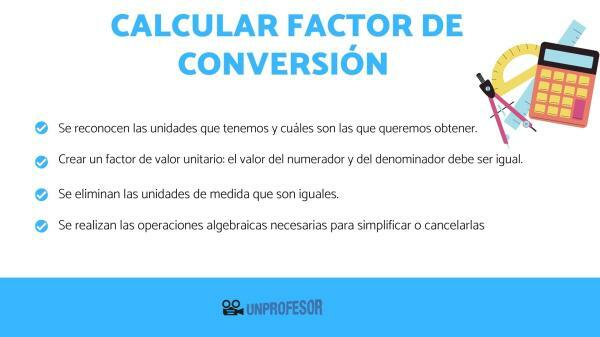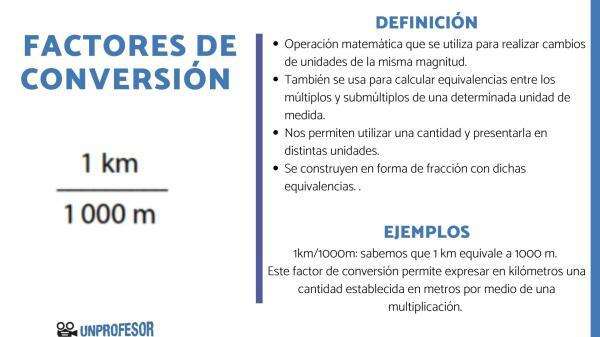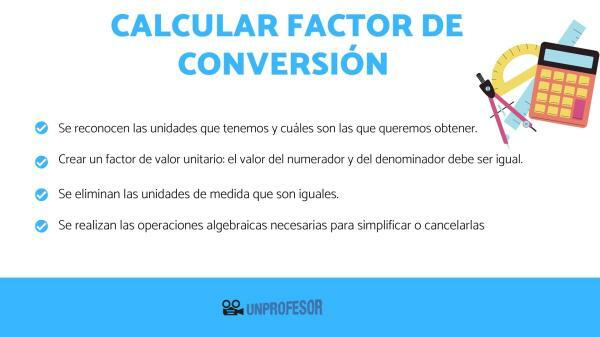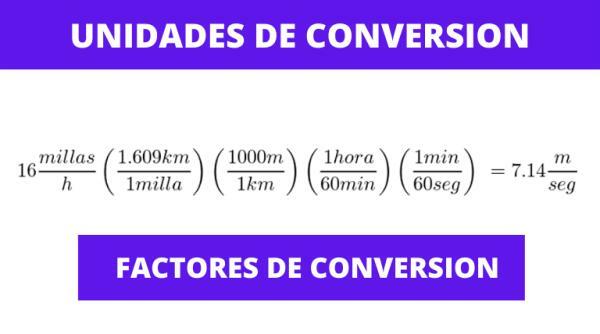How the conversion factor is calculated

In this lesson from a PROFESSOR we will see how the conversion factor is calculated and for this, we will first review what a conversion factor is, what are the units of measurement and what it is used for. Finally, we will see how the conversion factor is calculated with simple instructions to be able to do this exercise at home.
Index
- What is a conversion factor?
- Measurement units
- Discover how the conversion factor is calculated: step by step
- Other Examples of Conversion Factors
What is a conversion factor?
A Conversion factor is the number or fraction that is used to convert one measurement into another equivalent to her. For this, the International System of Units, the metric system or the Anglo-Saxon system of measurements are generally used.
The unit conversion method consists of transform the value or number of a quantity expressed in one system of units, in another that is equivalent to another system of units.
It is for this very purpose that conversion factors are generally used. These factors are what we multiply by the number of the magnitude that we want or need to transform.
In the event that a conversion involves us transforming various units of measurement, we can use different conversion factors to find the desired unit of measure.

Measurement units.
The measurements are based on some internationally established standards and they never change their value. Using these patterns makes it much easier to convert between different units of measurement.
This is why, as a conversion factor, the basic units of measurement that were agreed according to the International System of Units. The best known are:
- Meter: measures length.
- Kilogram: measures mass.
- Second: measure time.
- Mol: measures amount of substance.
- Ampere: measures the intensity of an electric current.
- Kelvin: measures the temperature.
- Candela: measures the intensity of light.
Examples of basic and derived conversion factors
We can use the following equivalences to be able to transform one measure into another:
- 1 inch = 2.54cm
- 1 foot = 12 in = 30.48 cm
- 1 yard = 91.44 cm
- 1 mile = 1.609347 km
- 1 league = 3 mi = 4.828032 km
- 1 gallon = 3.78541 liters
- 1 liter = 1000 milliliters
- 1 pound = 16 ounces
- 1 kilogram = 1,000 grams
- 1 pound = 453.592 grams
- 1 minute = 60 seconds
- 1 hour = 60 minutes
- 1 day = 24 hours

Discover how the conversion factor is calculated: step by step.
Let's see the procedure that we must follow to be able to calculate the conversion factor of any unit of measurement.
For calculate a conversion factor we must follow the following steps:
- The units we have and which ones we want to obtain are recognized.
- A unitary value factor must be created, that is, the value of the numerator and denominator must be the same. To achieve this, we must place the units of measurement in the numerator and denominator in such a way that the previous units are canceled and only the new ones remain.
- The units of measurement that are the same and that appear in both the numerator and the denominator are eliminated, that is, we use the cancellation property with the units.
- The necessary algebraic operations are carried out to simplify or cancel them.
Example
Let's see a simple example of how to use the conversion factor
Suppose we want to convert a measure of time from days to hours, then we must calculate a conversion factor that allows us to do so. For them we use the equivalence 1 day = 24 hours since we know that a day has 24 hours.
So this is the conversion factor we need to use to figure out how many hours equals so many days.
For example, if we want to know how many hours are equal to 2 days, we have to multiply (24 h/1 day) x 2 d. Applying the cancellation property, we can simplify the unit of measure day, and as a result we obtain that 2 days are equal to 48 hours.
Another example could be the following: if a 1 foot is 12 inches, then the conversion factor we are going to use is 1 foot = 12 inches. If I want to know how many inches is 5 feet, I have to multiply (12 in/1 foot) x 5 feet. We apply the cancellation property and obtain as a result that 5 feet equals 60 inches.
With the same procedure, using the conversion factors, we will be able to convert all the measures we have into the measure we want to obtain.
Another way to write the fraction
If the original unit is in the numerator, then in the denominator we must write the same unit or vice versa. In this way we will be able to simplify it.
- We write the new unit, that is, the one we want to obtain in the missing part of the fraction we are putting together.
- We write the value "1" in the largest quantity to thus use the equivalence of the other unit.
- We write the equivalent amount of the other unit.
- We do the multiplication.
Example
Let's prove it with an example. We need to convert 1.5 km to meters.
The original unit of measurement is km, that is, the unit that we need to simplify is in the numerator. Therefore, in the fraction that we are going to use as a factor, we must write the unit of measurement km in the denominator, so that we can simplify it later.
In the next step we are going to write the unit of measurement that we want to arrive at in the numerator in this case of our conversion factor.
We write a 1 in the largest unit, in our case km is larger than m
Then we write the amount that is equivalent in the new unit of measurement, the one we want to obtain
Then we perform the multiplication that we put together and thus obtain the result.
1.5km x (1000m / 1km) = 1500m
Now we can ensure that 1.5 km is equivalent to 1500 m.

Other examples of conversion factors.
we continue to offer examples of conversion factors so you can better understand this lesson:
Suppose that the indication to consume a medicine is 1 milliliter per 10 kg of body weight and the person who wants to take it weighs 132,277 pounds.
We know that 1 kg is equal to 2.20462 pounds.
So:
1ml/10kg x 1kg/2.20462lb = 0.04536ml/lb
We can then say that the person must consume 0.04536 milliliters of medication for every pound they weigh, therefore,
0.04536×132.277 = approximately 6 milliliters
If we drive a vehicle that can reach a speed of 120 kilometers per hour and we want to know how many meters travels per minute, we must take into account that 1 kilometer is equivalent to 1,000 meters and that 1 hour is equivalent to 60 minutes.
So:
120km/h x 1,000m/km x 1h/60min = 2,000m/min
We can then ensure that 120 kilometers per hour is equivalent to 2,000 meters per minute.
"If you liked this article or think we could improve, give us your opinion."

If you want to read more articles similar to How the conversion factor is calculated, we recommend that you enter our category of Algebra.


